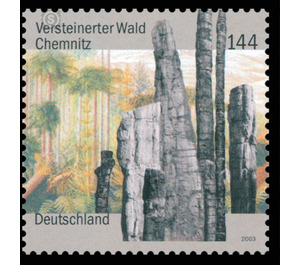Natural monuments in Germany - Germany / Federal Republic of Germany 2003 - 144 Euro Cent
Theme: Flora
| Country | Germany / Federal Republic of Germany |
| Issue Date | 2003 |
| Face Value | 144.00 |
| Perforation | K 13 1/4 |
| Stamp Type | Postage stamp |
| Item Type | Stamp |
| Chronological Issue Number | 2231 |
| Chronological Chapter | GER-BRD |
| SID | 151046 |
| In 41 Wishlists | |
A mighty volcanic eruption about 290 million years ago created a peculiar geological feature in what is today Chemnitz: the Petrified Forest. According to current research, the plants were preserved under tons of glowing rock material. Over time, silica and fluorspar got into the plant cells. They caused the so-called silicification of plant material in stone. What exactly happens with this rare phenomenon has yet to be completely clarified by science. The sites in Chemnitz are considered the oldest and most important of their kind worldwide. Already the Chemnitz mayor and scholar Agricola (1494 to 1555) mentioned such stones, which were once very popular in polished form as pieces of jewelry. Under the direction of Johann Traugott Sterzel (1841-1914), at the end of the 19th century in the Chemnitz suburb of Hilbersdorf, dug after such fossils systematically. Since the end of 2001, the Museum of Natural History Chemnitz has conveyed the fascination of petrified wood. Some of the silicified tree trunks from the region are set up in front of the museum.


